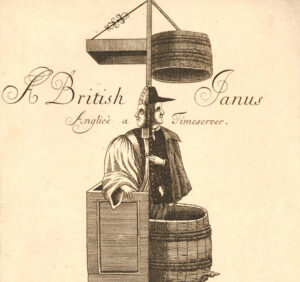We’re on the downhill side now of the Twelve Days of Christmas with just a few festive days to go, and once Epiphany passes it is no longer considered bad luck to remove the Christmas decorations, but if you’re like us and very much in love with Christmas, you are welcome to do as we do and follow the tradition in which the Christmas greenery stays up until Candlemas to brighten all your wintry January days. We only got our Christmas tree and put our decorations up a few days before Christmas, so to us, it is still fresh and new and still a delight. Father Christmas has not worn out his welcome. Not at all. But you, of course, have to do what is right for you.
We’ve been so immersed in Christmas that your printable Convivio Book of Days calendar for the month of January is a bit late, but here it is all the same. Janus, the Roman god who looks both back to the past and forward to the future, gives the month its name and so our cover star this month is an image of Janus; the one we found for you is called “A British Janus,” and it is a bit of satire of the sort you may have found in 1709, when the image appeared on a printed broadside in Britain. Janus sees past and future and this he does by having two opposing faces, which, of course, also lends itself to the term two-faced and that, I think, is the theme of this particular broadside from 1709. It has something to do with Puritans and Catholics, if I’m reading the text properly, but who am I to say. I’m no Puritan, and I’m pretty sure the Puritans would have frowned upon most everything I discuss in this Book of Days. My heritage is Catholic, and Italian, no less, and between the two, we are a very dramatic people. The celebrations of each day are wonderful, and so are the stories, all of which make, I think, for a good book of this sort. (And I imagine a Puritan Book of Days would be very brief, indeed.)
And so this month brings the second half of the Twelve Days of Christmas (which, lucky for us, survived the Puritans in spite of all their efforts at quashing it) with the boisterous Twelfth Night and then Epiphany about to come. Twelfth Night on Friday, Epiphany on Saturday… we’ll be visited by the last of the Midwinter gift bearers in the form of la befana, the kindly old witch from Italy, and the Three Kings themselves who finally arrive at the stable to see the child after twelve days and nights following a star. St. Distaff’s Day will follow the next day. Historically speaking, St. Distaff’s Day is when the greenery that was wound through the spinning wheel on Christmas Eve would be removed, so that women could get back to their spinning… though with St. Distaff’s Day falling on a Sunday this year, perhaps the women would be off until Monday, and it is Monday that brings Plough Monday, when the men get back to work. In the Netherlands, this Monday following Epiphany also brings Copperman’s Day, a day particularly special to me as a letterpress printer, for print shop apprentices would get the day off to work on projects of their own on Copperman’s Day, and for several years now, I’ve been printing an annual Copperman’s Day print myself, on or around this date. Considering my track record, this year’s will probably be late, just like this month’s calendar.
January is one of the more literary months of the year. It brings St. Agnes Eve as the 20th becomes the 21st, and on this night, young women would conjure up images of their future husbands through divination. It’s a night for which, in 1820, John Keats wrote a long and lovely poem, which would make for perfect reading on the Eve of St. Agnes (and that is the title he gave the poem). A few days later comes Burns Night, when we remember the great Robert Burns, the Bard of Scotland, with Burns Night Suppers and readings of his work.
And come Candlemas Eve, once January welcomes February, Robert Herrick reminds us that is indeed time to remove the Yuletide greenery from our homes. It is then, just about 40 days past the Midwinter solstice, that St. Brigid welcomes us to take our first step onto her bridge toward spring. Ah, but I’m getting far ahead of myself. For now, January is young, as is the new year. We look to the past and to the future, following the example of Janus, and we live in the present of a cold and wintry month.
TWELVE DAYS of CHRISTMAS SALE
At our online shop, our Twelve Days of Christmas Sale continues through January 6 and brings you automatic markdowns on most of our authentic German handmade nutcrackers, pyramids, and incense smokers, and chocolates and cookies, too. If there are things you wished for that Santa couldn’t fit in his sleigh, well, we’re here to help (and to offer you our best prices of the year, too). CLICK HERE to shop!
Image: “A British Janus” by an unknown artist. Engraving on paper, 1709, British Museum [Public domain via Wikimedia Commons].
